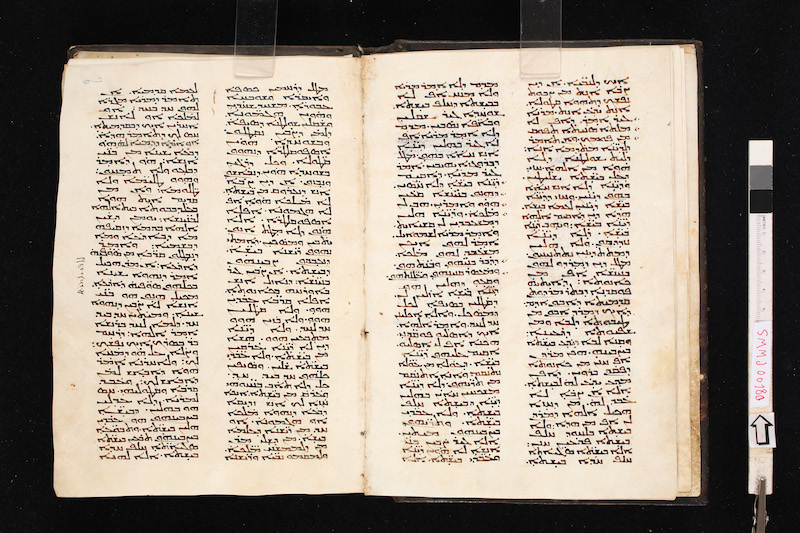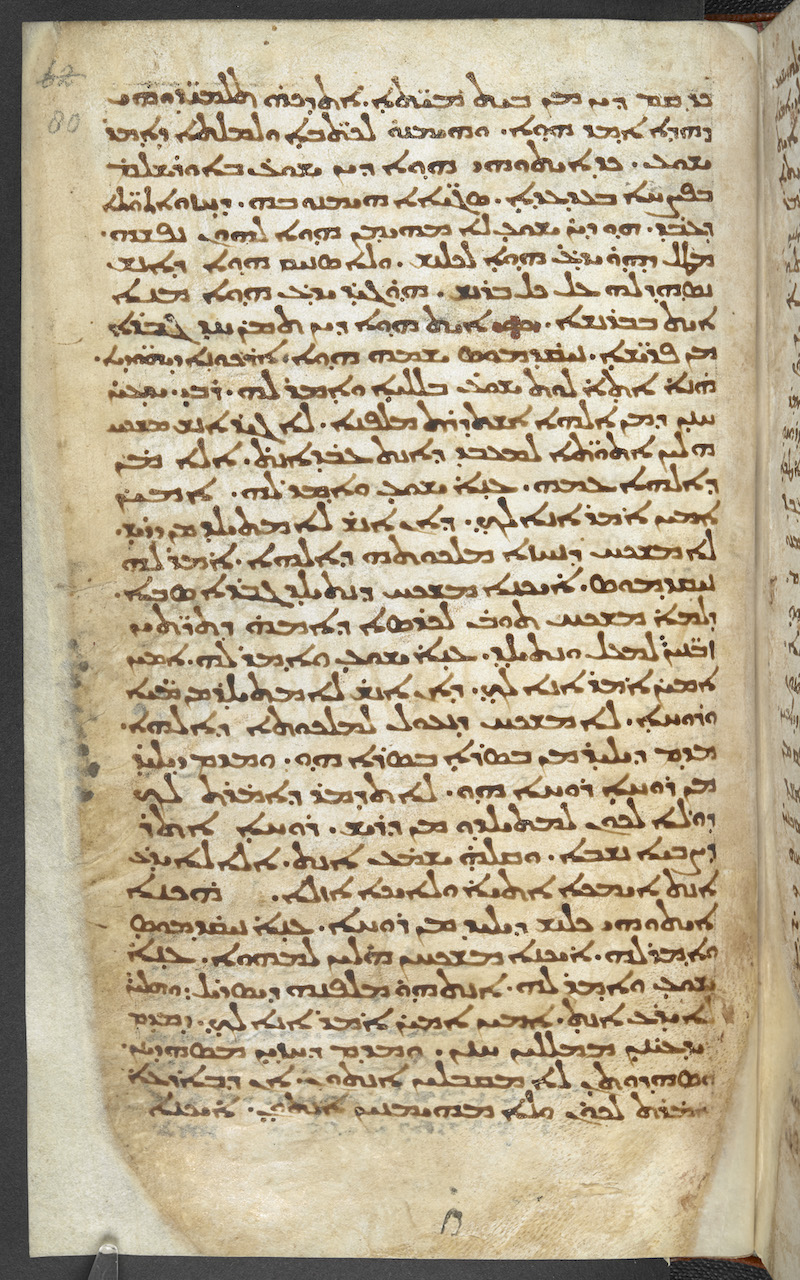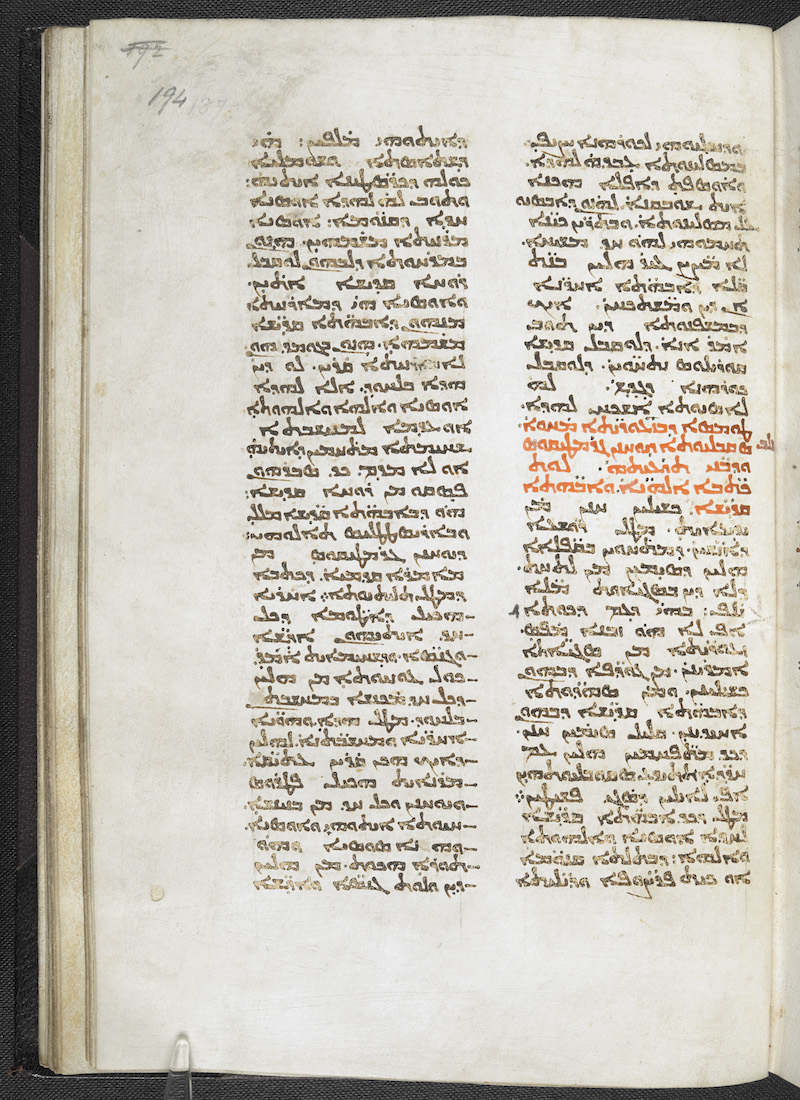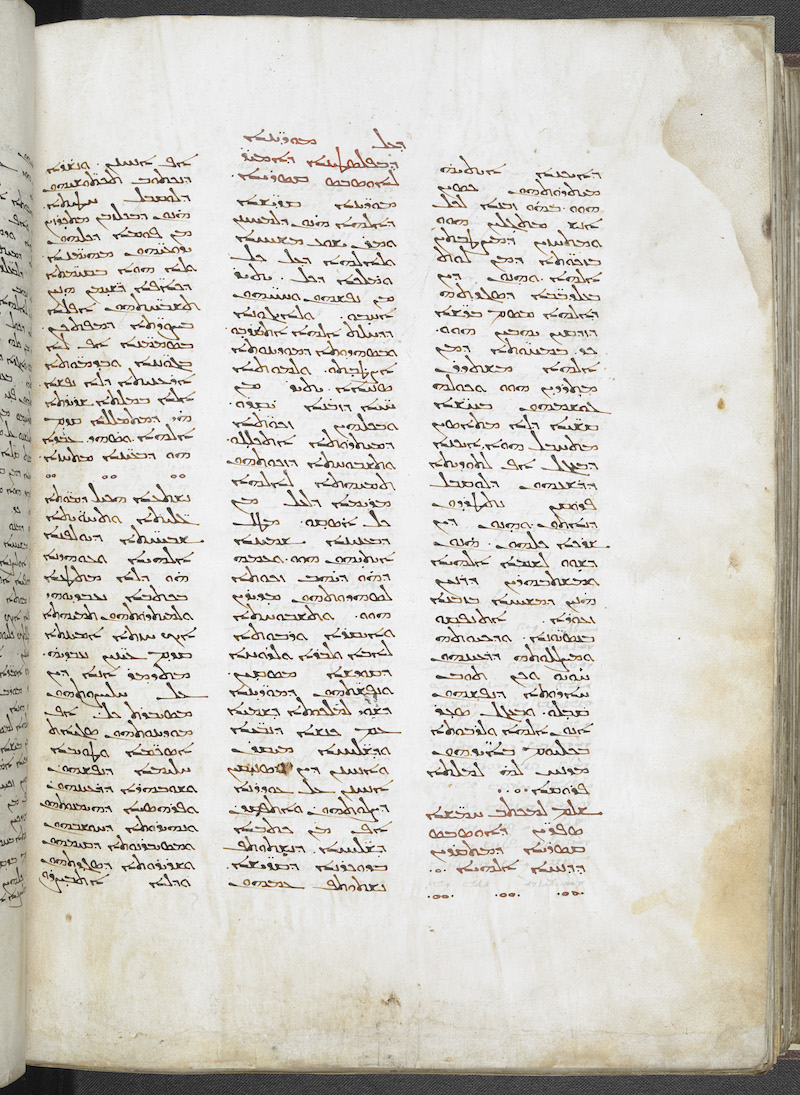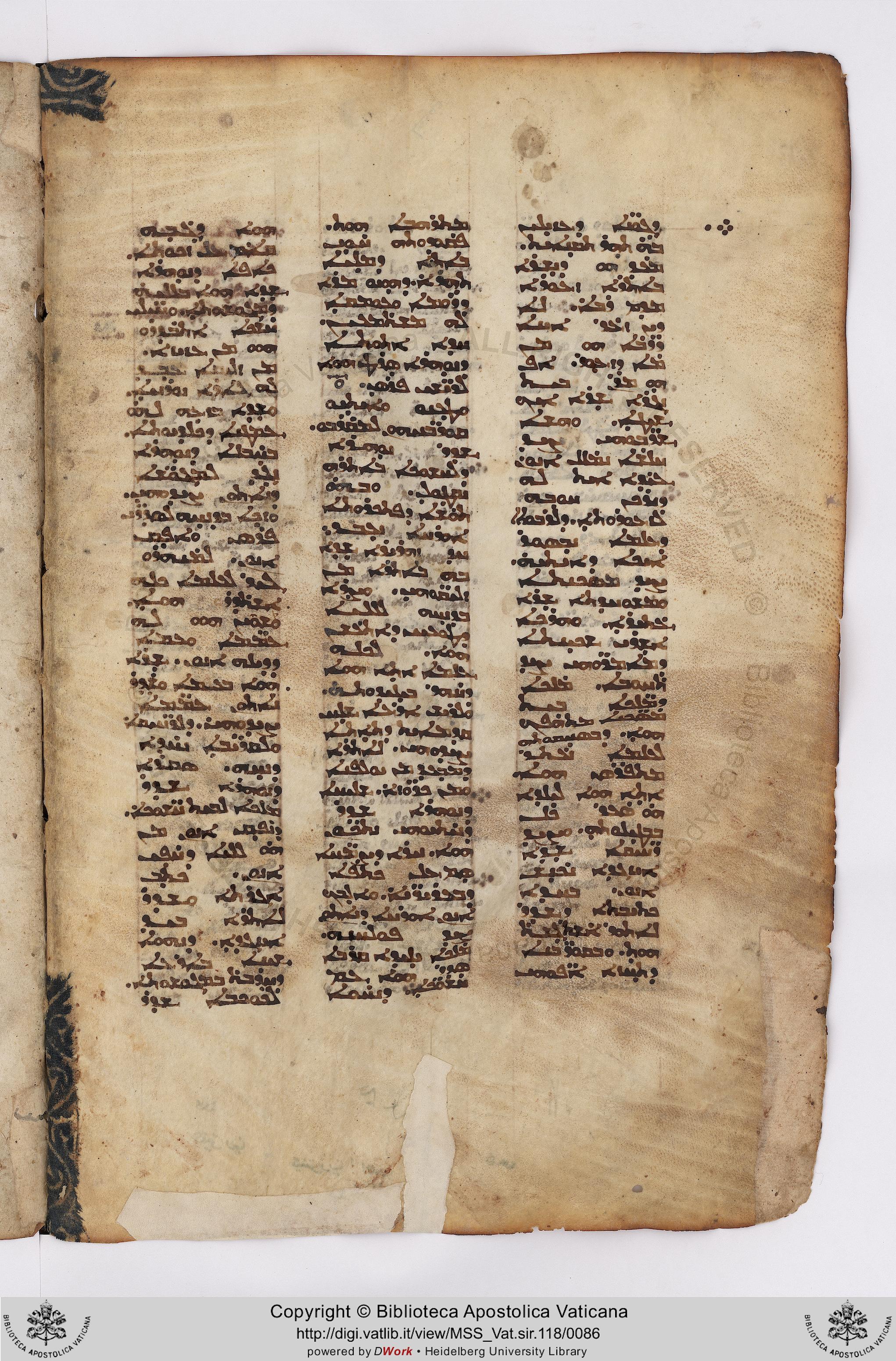
Estrangela, 12th century
-
Title
Jacob of Serugh, Memre -
Text
Memra on the Star Seen by the Magi and on the Murder of the Infants -
Language(s)
Syriac -
Writing System
Syriac -
Script(s)
Estrangela -
City
Vatican City -
Repository
Biblioteca Apostolica Vaticana -
Shelf Mark
Sir. 118, fol. 40v -
Century
12th century -
Year Range
1121-1121 -
Date Precise
June 12, 1121 CE -
Provenance
Fol. 261v: colophon (re-copied in Serto on 262r) with the date Ḥzirān 12, 1432 (= June 12, 1121 CE). -
Bibliography
S.E. Assemani and J.S. Assemani, Bibliothecae Apostolicae Vaticanae codicum manuscriptorum catalogus, I.3 (1759), p. 107-115.
Arthur Vööbus, Handschriftliche Überlieferungen der Mēmrē-Dichtung des Jaʿqōb von Serūg, vol. 1, CSCO 344/Subsidia 39 (1973), p. 118.
Kristian Heal, “Vatican Syriac Manuscripts, Volume 1,” Hugoye 8 (2005), p. 120.
-
External Facsimile
319 leaves, on parchment. 3 columns, 38-40 lines; support dimensions 41.2 x 28 cm
The text of the memra was edited on the basis of this manuscript by Paul Bedjan, Homiliae Selectae Mar Jacobi Sarugensis, vol. 1 (1905), p. 84-152. The text on this folio corresponds to p. 86.16-88.17. On p. vii Bedjan describes this manuscript as having “très belle écriture en estrangélo…très lisible.”
Acknowledgements: Described by Adam McCollum
Transcription
col. a
01 ܕܓܘ̈ܢܐ ܕܥܙܝ̣ܠܝܢ
02 ܒܗ̇ ܬܗ̣ܪ ܬܩܢ̣ܐܝܬ.
03 ܡܥ̇ܕ ܗܘ ܕܢ̣ܫܪܐ
04 ܒܐܬܪܐ ܙܥܘܪܐ
05 ܡܕܡ ܪܒܐ܇ ܠܐ
06 ܕܝܢ ܙܥ̇ܪ ܐܝܢܐ
07 ܕܪܒ̇ܐ ܗܘ ܡܢ
08 ܡܐ ܕܙܥ̣ܘܪ. ܐܦ
09 ܗܘ̣ ܡܪܢ ܒܝܬ
10 ܢܓܪܐ ܫ̣ܪܐ ܐܝܟ
11 ܫܝܛܐ܉ ܘܗܫܐ
12 ܫܪ̈ܒܘܗܝ ܨܝܕ
13 ܚܠ̇ܫܐ ܢܡ̇ܠܠ ܐܢܘܢ̇
14 ܥܝ̇ܕܐ ܐܝܬ ܠܗ
15 ܕܢܪܟܢ ܚܘܒ̣ܗ
17 ܠܙܥܘܪܘܬܐ܉ ܕܠܪܒܘܬܐ
18 ܕܥܠܡܐ ܢܒ̣ܣܘܪ
19 ܐܝܟܐ ܕܐܝܬܝܗ̇.
20 ܨܝܕ ܡܣܟܢܬܐ
21 ܘܡܫܘܚܕܬܐ ܫ̣ܪܐ
22 ܥ̇ܬܝܪܐ܉ ܘܗܪܟܐ
23 ܐܫ̣ܪܝ ܫܟܝ̣ܢܬܐ
24 ܕܡܐܡܪ̈ܘܗܝ ܨܝܕ
25 ܬ̇ܚܘܒܐ. ܡ̇ܠܟܐ
26 ܕܡ̈ܠܟܐ ܒܝܬ
27 ܡܣ̈ܟܢܐ ܡܬܗ̇ܦܟ
28 ܗܘܐ܉ ܕܒܣܢܝ̣ܩܘܬܗ
29 ܠܥܠܡܐ ܢܥ̇ܬܪ
30 ܡܬܦ̇ܪܣ ܗܘܐ.
31 ܐܬ̣ܐ ܗܘܐ ܠܝܠܕܐ
32 ܗ̇ܘ ܣ̇ܥܪ ܟ̇ܠ
33 ܒܒܛܝ̣ܠܘܬܗ܉ ܘܨܝܕ
34 ܪ̈ܚܝܩܐ ܫ̣ܪܐ
35 ܐܝܙܓܕܐ ܢܟ̇ܢ̣ܫ
36 ܐܢܘܢ. ܒܚܕܐ
37 ܟܬܝܒܬܐ ܕܫܕܪ
38 ܠܐܬܘܪ ܐ̇ܫܬܓ̣ܫܬ̇
39 ܗܘܬ܉ ܘܒܩܘܪ̈ܒܢܐ
40 ܕܬ̣ܚܙܐ ܐ̈ܦܘܗܝ
col. b
01 ܡܬܪܗܒܐ ܗܘܬ.
02 ܦܩܘܕܘܬܗ ܚܘ̣ܝ
03 ܒܐܬ̣ܐ ܕܡܠ̣ܝܐ
04 ܬܗ̣ܪܐ܇ ܕܗܘ̣ܝܘ ܡܪܐ
05 ܕܪܘܡܐ ܘܥܘܡܩܐ̣
06 ܠܗ ܡܫܬ̇ܡܥܝܢ.
07 ܚܕܐ ܐܬܘܬܐ
08 ܕܢܘ̣ܗܪܐ ܣ̣ܪܛ ܗܘܐ
09 ܠܪ̈ܝܫܝ ܦܪܣ܉ ܘ̄
10 ܘܛܥ̣ܢܘ ܘܐܝܬ̣ܝܘ
11 ܩܘܪ̈ܒܢܝܗܘܢ ܠܡܩ̇ܪܒܘ.
12 ܫܕܪ ܢܘ̣ܗܪܐ
13 ܕܠܚܫܘܟܐ ܒܐܬܪܗ
14 ܢܩܛ̣ܘܠ܉ ܘܒܗ̇ܘ
15 ܬܘ̇ܫܐ ܕܦܬܟܪܘܬܐ
16 ܐܘܪܚܐ ܢܥ̣ܒܕ܉
17 ܚܕ ܙܗܪܝܪܐ ܫ̣ܪܐ
18 ܒܗ ܒܐܬܪܐ ܡܢ
19 ܙܠܝܩ̈ܘܗܝ܉ ܘܨ̣ܪܐ
20 ܒܕܢܚ̣ܗ ܠܠܠܝܐ
21 ܕܛܘܥܝܝ ܕܐܬܥ̇ܫܢ
22 ܗܘܐ. ܠܟܠܗ
23 ܥܠܡܐ ܐܬ̣ܐ ܗܘܐ
24 ܕܢ̇ܢܗܪ ܒܝ̣ܠܝܕܘܬܗ܇
25 ܘܠܪܝܫ ܐܪܥܐ ܫܠ̣ܚ
26 ܩܕܡܐܝܬ ܕܬܐ̣ܬܐ
27 ܨܝܕܘܗܝ. ܠܐܬܪܐ
28 ܕܡܒ̣ܥܕ ܡܢ ܝܘܠܦܢܐ
29 ܘܡܢ ܟܪ̈ܘܙܐ܇ ܫܠܝܚܐ
30 ܕܢܘܗܪܐ ܫܕܪ
31 ܕܢ̇ܝܬܝܘܗܝ ܢܬܟ̇ܘܢ
32 ܗܘܐ. ܢܝܪܐ ܕܨ̣ܡܚ̈ܐ
33 ܣ̣ܡ ܥܠ ܟܬܦܐ
34 ܕܒܥܪܝܪ̈ܝܐ܇ ܘܐܠ̣ܒܟ
35 ܐܢܘܢ ܐܘܪܚܐ ܕܢܐܬܘܢ
36 ܨܝܕ ܦܘܠܚܢܗ.
37 ܡ̇ܠܟܐ ܝܠ̣ܝܕܐ ܩܪܒܐ
38 ܣ̣ܕܪ ܗܘܐ ܥܡ
39 ܚܫܘ̈ܟܐ܉ ܕܢܚ̇ܘܐ
col. c
01 ܗܘܐ ܕܓ̇ܒ̣ܗ
02 ܩܐ̇ܡ ܥܠ ܙܟܘܬܐ.
03 ܟܐܦܐ ܘܢܘܗܪܐ
04 ܫ̣ܕܐ ܗܘܐ ܒܠܠܝܗ̇
05 ܕܡܓܘܫܘܬܐ܉ ܘܚ̈ܝܠܝ
06 ܚܫܟܐ ܐܬܒ̇ܕܪܘ
07 ܗܘܘ ܡܢ ܥܙܝܙܐ.
08 ܡܢ ܙܠܝܩܐ ܥܒ̣ܕ
09 ܠܗ ܓܐܪܐ ܢܘܪܢܝܐ܉
10 ܘܫ̣ܕܐ ܒܙܥܗ ܠܗ̇ܘ
11 ܥܡܛܢܐ ܕܟ̇ܠܕܝܘܬܐ.
12 ܒܚܲܒܠܐ ܕܢܘ̣ܗܪܐ
13 ܢܓ̣ܕ ܠܡܓܘ̈ܫܐ
14 ܕܢܐܬܘܢ ܨܝܕܘܗܝ܉
15 ܘܙܟ̣ܐ ܒܕܢ̣ܚܗ ܠܣܕܪ̈ܝ
16 ܦܪܣ ܘܐܦ̣ܩ
17 ܐܢܘܢ. ܠܡ̇ܢܗܪܘ
18 ܓܝܪ ܠܥܠܡܐ ܟܠܗ
19 ܐܫܬ̇ܕܪ ܗܘܐ܉
20 ܘܰܫܘܶܝܢ ܗܘܘ ܠܗ
21 ܥܡ̈ܡܐ ܘܥܡܐ
22 ܕܕܝܠܗ ܐܢܘܢ. ܫ̣ܪܐ
23 ܗܘܐ ܒܥܡܐ ܘܫܲܕܪ
24 ܢܐܬܘܢ ܥܡ̈ܡܐ
25 ܨܝܕܘܗܝ܇ ܕܠܪ̈ܚܝܩܐ̇
26 ܘܠܩܪ̈ܝܒܐ̣ ܢܚ̇ܕܐ
27 ܕܢܚ̣ܗ. ܣܩܪܐ
28 ܕܢܘܗܪܐ ܫܕܪ
29 ܡܠܟܐ ܠܒܝܬ ܚ̈ܫܘܟܐ܇
30 ܕܢ̇ܦ̣ܩ ܐܢܘܢ ܡܢ
31 ܗ̇ܘ ܠܠܝܐ ܕܚ̇ܦ̣ܝ
32 ܐܢܘܢ. ܟܬ̣ܒ
33 ܐܓܪܬܐ ܘܫܕܪ
34 ܠܐܬܪܐ ܒܝܕ
35 ܐܝܙܓܕܐ܉ ܕܢܗܘܐ
36 ܫܝܢܐ ܒܐܪܥܐ
37 ܕܚ̣ܪܒܬ̇ ܒܡܓܘܫܘܬܐ.
38 ܠܟܘܟܒܐ ܫܕܪ
Paleographic Features
The script has a very thick, sharp character. The plethora of dots and the close spacing of the lines sometimes requires close attention to determine the scribe’s intentions.
In col. b, the scribe first wrote w- at the end of line 9, with an overline to indicate that the word is incomplete. Line 10 begins with the complete word, consisting of the conjunction joined to the verb.
Dālat at the end of col. b, line 16 is missing the underdot, or one of the dots of the punctuation is doing double duty.
Note the West Syriac vowels in col. c, line 20.
1. ālap: top part, ending in a dot, much thinner than the bottom part
2. gāmal: very thick dot at the bottom; the top arm has a narrowed middle
3. dālat\ rēš: Serto shape, with a very thick dot as the topmost part
4. hē: Serto shape, with closed loop on left
5. wāw: a perfect o shape
6. zayn: does not hang below line
7. ṭēt: the top and bottom parts are each about the same height
8. yod: very short
9. mim: top line angles upward; closed loop
10. semkat: left loop only very slightly taller than the right; neither loop pointed
11. ʿē: the top arm has a narrowed middle
12. pē: rather tall
13. ṣādē: thin descender
14. šin: top part essentially a flat line
15. tāw: closed loop
